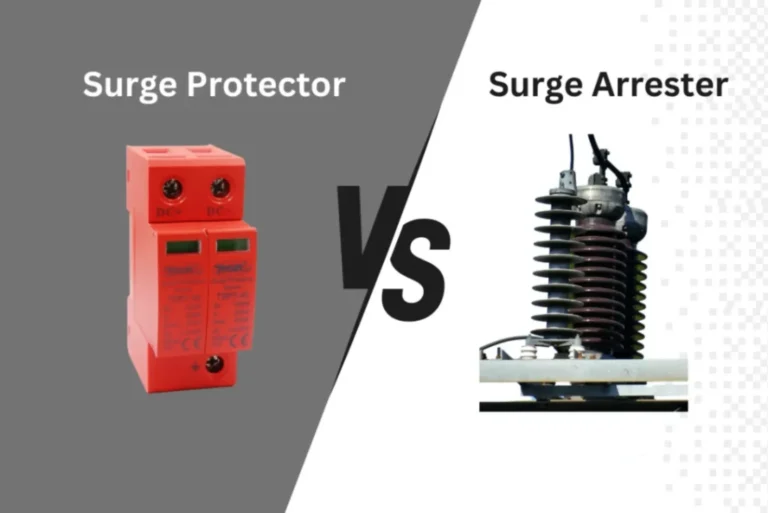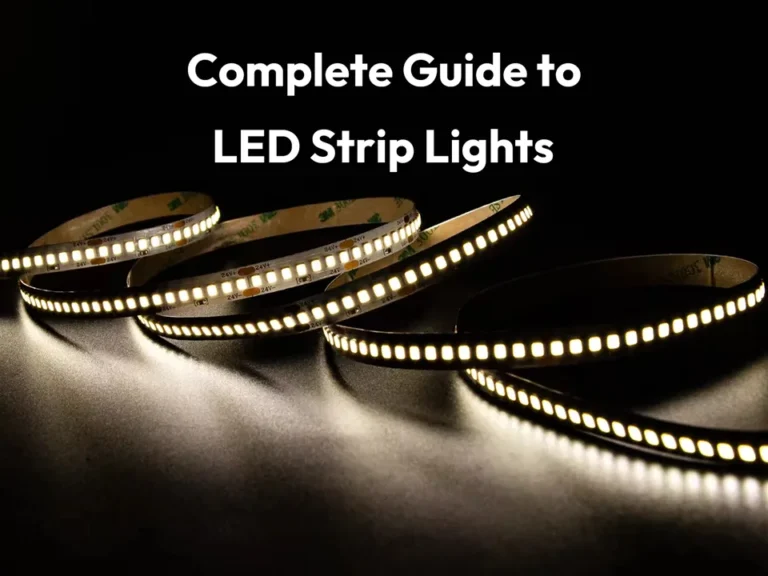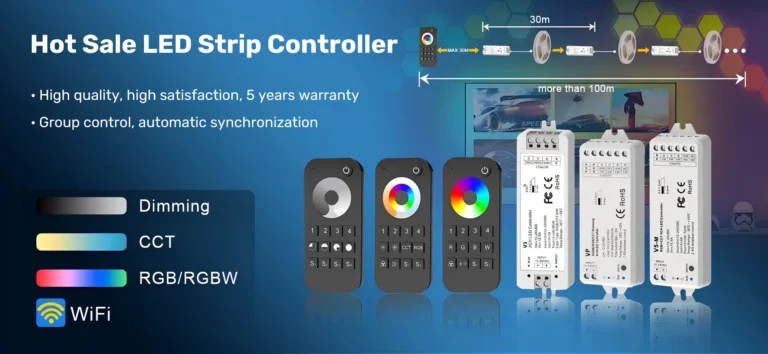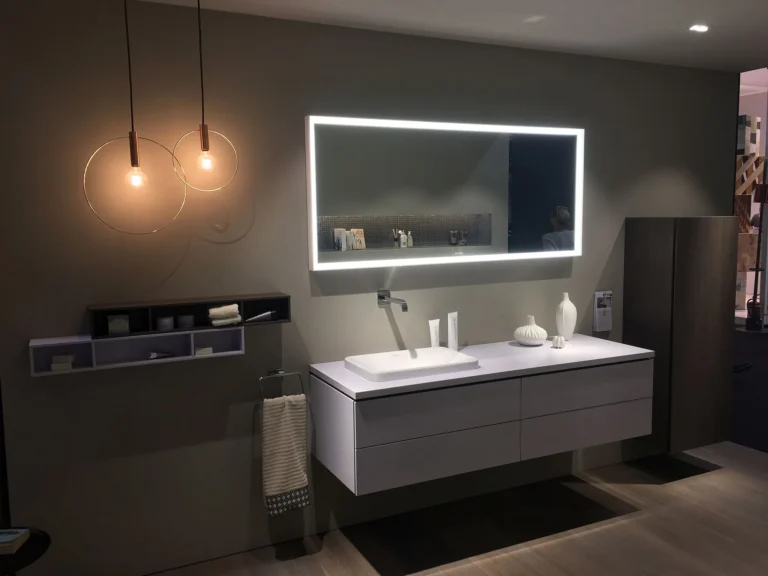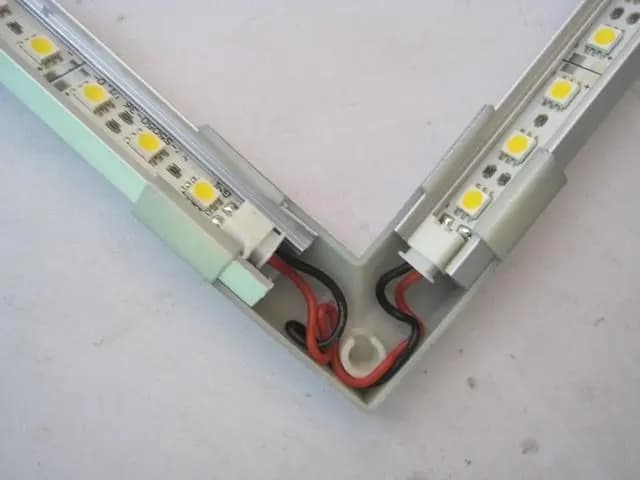ダイナミックな RGB 照明に関しては、ほとんどの人が低電圧 DC アドレス指定可能なストリップを考えています。 しかし、近年、静かな変化が起こっています。より多くの請負業者や照明専門家が、大規模な屋外および建築プロジェクトのために AC アドレス可能な LED ストリップ ライトを選択しています。 なんでですか? AC RGB ストリップは電圧降下なしで最大 50 メートル走行できるため、かさばる電源を必要とせず、プラグ アンド プレイの利便性を提供します。 DC ストリップは細かい制御と柔軟性を提供しますが、AC バージョンは、特に 110V または 220V リージョンで、シンプルさ、距離、およびコスト効率で優れています。 この記事では、AC アドレスと DC アドレス指定可能な LED ストリップの主な違いを調べ、次のプロジェクトに適した選択を判断するのに役立ちます。

AC アドレス指定可能な LED ストリップ ライトとは何ですか?
AC アドレス可能な LED ストリップ ライトは、低電圧電源を必要とせずにダイナミックな照明効果を表示できる高電圧 RGB ストリップです。 110V または 220V AC 入力で直接動作するように設計されたこれらのストリップは、内蔵整流回路を使用して交流を直流に変換し、一貫した安全な動作を可能にします。
外部コントローラと電源アダプターを必要とする標準の DC アドレス指定可能なストリップとは異なり、AC RGB ストリップはプラグアンドプレイ キットに組み込まれていることが多く、1 回の実行で最大 50 メートルの長距離設置に最適です。
これらのストリップは通常、セミアドレスで指定できます。つまり、各セグメント (多くの場合、1 メートルまたは 0.5 メートル) は、内蔵の IC タイプに応じて、異なる色や追跡効果を表示できます。
一般的な IC オプションには次のものがあります。
SM16703/SM16716: セグメントレベルの動的効果をサポートします。
TM1934 など: 防水屋外アプリケーションでよく使用されます。
内部 MCU ベースの IC: 特定の効果のために AC ドライバー モジュールに組み込まれたカスタム IC。
主な特徴
110V または 220V で直接動作します
長時間の単回走行機能 (最大 50m)
IP65–IP68 防水オプション
簡単な設置、屋外または商業用照明に最適
ブリットイン プログラムでコントローラーなしで動作します
DC アドレス指定可能な LED ストリップ ライトとは何ですか?
DC アドレス可能な LED ストリップ ライトは、外部コントローラーを使用してピクセル レベルの照明制御を可能にする低電圧 RGB ストリップです。 通常、5V、12V、または 24V DC で動作し、装飾、看板、アニメーションの照明プロジェクトで広く使用されています。
主なコントロール タイプは 2 つあります。
SPI (シリアル ペリフェラル インターフェイス):
複雑な照明効果とピクセル制御に最適です。 各 LED (またはグループ) には独自のアドレスがあります。
一般的な IC: WS2812B、WS2811、SK6812、UCS1903、APA102。
DMX (デジタルマルチプレックス):
ステージ、イベント、建物のファサード照明などのプロの照明システムで使用されます。
一般的な IC: TM512、TM1934、SM17512、UCS512C。
DC アドレス指定可能なストリップは、柔軟性、スムーズな効果、精度を提供しますが、コントローラーと電源が必要です。 電圧降下の制限により、短時間から中程度の長さの実行に最適です。
DC アドレス指定可能な LED ストリップ ライトについて詳しく知りたい場合は、こちらの詳細ガイドをご覧ください。 ピクセル・アドレサブルLEDストリップの比較:DMX512とSPIの比較

AC と DC のアドレス指定可能な LED ストリップ: 違いは何ですか?
AC と DC のアドレス指定可能な LED ストリップ ライトの選択は、プロジェクトのニーズに応じて、設置のシンプルさ、制御精度、安全性、長距離性能などに依存します。
AC アドレス可能なストリップは、110V または 220V に直接接続するように設計されているため、長時間の実行と迅速な設置が最も重要な屋外または大規模なプロジェクトに最適です。 これらのストリップは通常、セグメント レベルの効果 (たとえば、50cm または 1m ごと) を提供し、プラグ アンド プレイ コントローラーが付属しています。 外部電源は必要ありません。明るさの低下が目立たず、1 回の実行で最大 50 メートルに達することができます。
一方、DC アドレス指定可能なストリップは、安全な低電圧電力 (5V/12V/24V) で動作し、ピクセルレベルの制御を提供します。 豊富なアニメーション効果をサポートし、サイネージ、インテリア デザイン、ゲームのセットアップ、インタラクティブなインストールで広く使用されています。 ただし、外部電源が必要であり、電圧降下が数メートル後に問題になり、設置がより複雑になります。
つまり、AC = シンプルさと距離を示し、DC = 制御と精度です。
| 特徴 | AC アドレス指定可能なストリップ | DC アドレス指定可能なストリップ |
| 使用電圧 | 110V / 220V AC | 5V / 12V / 24V DC |
| 制御タイプ | セグメントレベル (基本効果) | ピクセルレベル (SPI/DMX による正確な制御) |
| 最大走行距離 | 50メートルまで | 5 ~ 10 メートル (電力注入が必要) |
| 電源が必要 | いいえ (内蔵整流器) | はい (外部ドライバーとコントローラー) |
| インストール | プラグアンドプレイ | 配線とセットアップが必要 |
| 安全性 | 電圧の高いリスク (保護が必要) | 低電圧、取り扱いに安全 |
| 柔軟性 | 剛性または半柔軟性 | 高い柔軟性 |
| 代表的なアプリケーション | 屋外のファサード、商用照明 | サイン、アニメーション、室内装飾 |
| コスト効率 | 長時間の実行時の総コストの削減 | アクセサリーのおかげでコストが高くなる |
AC RGB アドレス指定可能な LED ストリップ ライトの長所と短所
他の照明ソリューションと同様に、AC アドレス指定可能な RGB LED ストリップには、利点と制限の両方があります。 これらを理解することで、特に大規模または屋外照明プロジェクトで、アプリケーションに適した製品を選択することができます。
利点がある:
長連続走行(最大 50m)
電源注入や信号リピーターは不要です。 ファサード、廊下、または周囲の輪郭を構築するのに最適です。
プラグ アンド プレイのインストール
外部 DC 電源や複雑な配線は必要ありません。 設置作業と時間を節約できます。
システムコストの削減
アクセサリ (電源装置、アンプなど) が減ると、AC ストリップが大規模なプロジェクトに適した予算に対応できるようになります。
高防水オプション
多くのモデルには、雨、ほこり、雪での屋外での使用に最適な IP65 ~ IP68 保護が付属しています。
組み込み制御オプション
ほとんどのストリップには、色の追跡、呼吸、点滅などのダイナミックな効果を備えた基本的なコントローラーが含まれており、箱から出してすぐに使用できます。
デメリット
限定的なピクセル制御
AC ストリップは通常、LED ごとのアニメーションではなく、セグメントベースのエフェクトのみをサポートします。 ファイン 解像度のデザインやインタラクティブな照明には適していません。
電圧が高い=安全リスクが高い
110V または 220V への直接接続には、電気的危険を避けるために、慎重な取り扱いと適切な防水シールが必要です。
形状の柔軟性が低い
AC ストリップは、内部回路設計により、DC の対応物よりも硬くなっていることが多く、曲がりくねったり、形をしっかりと整えたりすることができません。
近距離の設置には最適ではありません
安全性と熱の考慮が必要なため、AC RGB ストリップは、手の届かない場所や屋外での設置に適しています。
AC アドレス指定可能な LED ストリップはどこで使用されますか?
長さが長く、防水性があり、プラグ アンド プレイのデザインのおかげで、AC アドレス指定可能な LED ストリップは、迅速な設置と幅広いカバレッジが重要な大規模および屋外プロジェクトで広く使用されています。 一般的なアプリケーションを次に示します。
1. 建物のファサード照明
AC RGB ストリップは、高層ビル、商業広場、建築物の概要を説明するのに最適です。 リールあたり最大 50 メートルのため、配線の複雑さを軽減しながら、長距離全体でダイナミックな色の効果をもたらします。 IP67 定格のバージョンは、一年中雨や風に耐えることができます。

2. 橋とトンネルの装飾
ブリッジ、トンネル、陸橋などのインフラストラクチャ プロジェクトでは、AC アドレス指定可能なストリップが最小限のメンテナンスで鮮やかな線形効果を提供します。 高電圧入力により、市の電力システムと互換性があり、防水により、露出した環境での安全な使用が保証されます。

3. ショッピング モールまたは商業用の周囲の照明
ルーフライン、入り口、または窓の端に沿って使用されるこれらのストリップは、建物の夜間の外観を向上させる注目を集める軽いアニメーションを作成できます。 内蔵のコントローラーにより、配線が簡素化され、厳しい締め切りの下で働く請負業者の時間を節約できます。
4. 屋外フェスティバルまたは休日のインスタレーション
クリスマス、新年、または市のイベントなどの一時的な設置の場合、AC ストリップを使用すると、アクセサリーを最小限に抑えて高速セットアップが可能になります。 プラグインの設計により、外部ドライバーが不要になり、季節の照明請負業者に最適です。
AC と DC RGB LED ストリップのどちらを選択するか: どれが必要ですか?
AC アドレスと DC アドレス指定可能な RGB LED ストリップのどちらを決定する場合、適切な選択は、プロジェクトの目標、インストール環境、および予算によって異なります。 それぞれのタイプには長所があります。どちらが優れているかではなく、どちらがニーズに合っているかということです。
次の場合は、AC RGB LED ストリップを選択してください。
電圧降下や電力注入なしで、長時間 (最大 50 メートル) を取り付ける必要があります。
このプロジェクトは、ファサード照明、看板の境界線、またはランドスケープ機能など、屋外または商業的です。
より少ないコンポーネントでより迅速なインストールが必要です。プラグ アンド プレイするだけです。
110V または 220V 電源を直接使用していて、アクセサリを最小限に抑えたいと考えています。
セグメントレベルの制御を備えた、費用対効果の高い大規模な照明を好む。
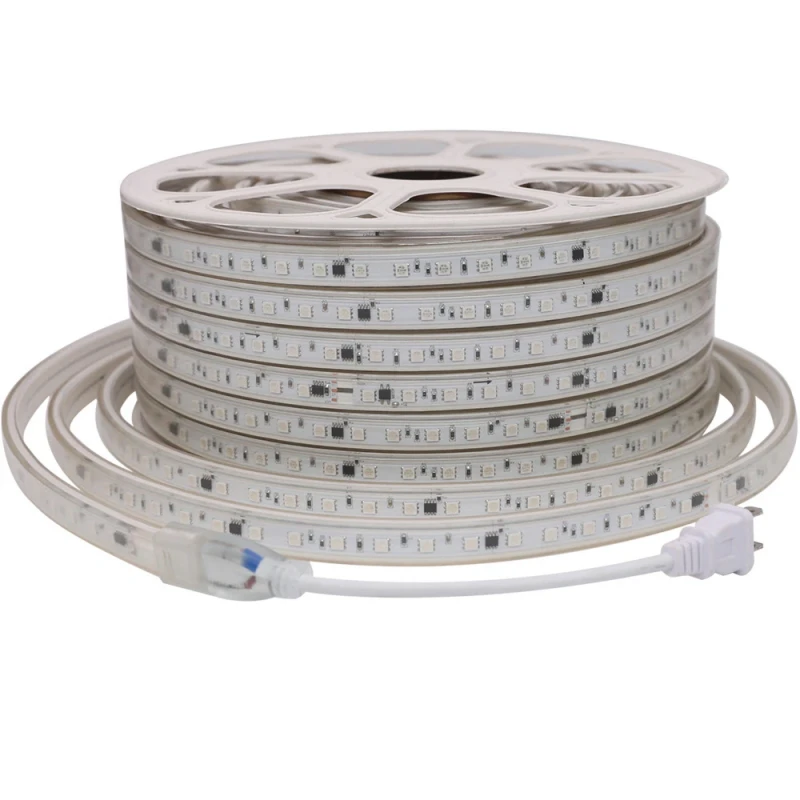
AC 110V/220V アドレス可能な LED ストリップ ライト
モデル番号: EAA10T060G
入力電圧AC110V/220V
ワット:10W/m
LED QTY: SMD5050 60LEDs/m
色温度: アドレス指定可能な RGB
IP等級:IP68
カット可能長さ: 1000mm
長さ:50メートル/ロール
保証: 2years
価格: 3 米ドル
次の場合は、DC RGB LED ストリップを選択してください。
個々の LED アニメーションや高度なエフェクトなど、正確なピクセル制御が必要です。
アプリケーションは、看板、ディスプレイ ケース、ゲーム ルームなど、屋内または装飾的です。
曲線、角、またはカスタム形状で柔軟に取り付ける必要があります。
コントローラ、電源装置、プログラミングの経験またはサポートがあります。
照明は、DMX ベースのショーや SPI 効果など、インタラクティブなシステムまたはクリエイティブ システムの一部です。
DC アドレス可能な RGB LED ストリップ ライトを購入したい場合は、ここをクリックしてさらに製品を確認してください。 DC アドレス指定可能なストリップ ライト
要するに:
AC = よりシンプル、より長い、屋外
DC = よりスマートで柔軟な詳細な制御
まだわからない? ハイブリッド アプローチも可能です。一部のプロジェクトでは、周囲の照明に AC ストリップを使用し、フォーカス アニメーション ゾーンに DC ストリップを使用します。
110V/220V AC LED ストリップ ライトを安全に使用する方法
AC RGB LED ストリップは利便性と長距離性能を提供しますが、高電圧 (110V または 220V) で動作するため、設置および使用中に安全性に細心の注意を払う必要があります。 以下は、商用および屋外環境で安全で信頼性の高い操作を保証するための重要なガイドラインです。
1. 防水コネクタとエンドキャップを使用
ストリップの両端は、必ず IP65+ 防水コネクタとシリコンで満たされたエンド キャップで密閉してください。 これにより、特に屋外またはセミオープンの設置では、水の侵入や短絡を防ぎます。
2. ストリップを手の届かないところにマウントする
高電圧のため、直接触れるストリップを配置しないでください。 リスクを軽減するために、高い壁、天井、ひさし、またはディフューザーの後ろに沿って設置してください。
3. 認定製品を選ぶ
安全基準への準拠を保証するために、CE、ETL、または UL 認証のストリップのみを使用してください。 安定した性能には、信頼性の高い内部ドライバと難燃性材料が不可欠です。
4. 漏れ防止 (RCD/RCBO) を使用します。
電源回路には、必ず残留電流デバイス (RCD) または RCBO を取り付けてください。 これらの安全スイッチは、漏れやショートの場合にすぐに電源を遮断し、人と財産の両方を保護します。
5. 操作中のコイル状の発生を避ける
コイル状または密閉ループ中は、過熱の原因となる可能性があるため、AC LED ストリップを操作しないでください。 アルミニウムや PVC チャネルなどの放熱面に必ず完全に広げて取り付けてください。
6. すべての電源ポイントにラベルを付けて固定する
すべての AC 接続点を明確にマークし、熱収縮スリーブまたは断熱箱を使用して、露出した端子を保護します。 コントロール ボックスと電源インターフェースは湿気や破壊行為から保護します。
これらの予防措置を講じることで、AC RGB ストリップの設置は素晴らしいだけでなく、安全で耐久性があり、国際規格に準拠しています。

AC アドレス指定可能な RGB LED ストリップ ライト ファクトリー
AC アドレスと DC アドレス可能な RGB LED ストリップのワンストップ サプライヤーをお探しですか?
SignLite は、商業、建築、装飾プロジェクト向けの高品質 RGB 照明ソリューションを幅広く提供します。
110V/220V AC の AC RGB ストリップと 5V/12V/24V DC ピクセル ストリップの両方を製造し、長距離の建物のアウトラインから詳細なアニメーション照明まで、あらゆるものをサポートします。 プラグ アンド プレイの利便性やピクセル レベルの制御が必要な場合でも、当社が対応します。
また、カスタマイズもサポートしています。長さ、防水レベル、色効果、および制御方法はすべて、プロジェクトのニーズに合わせて調整できます。
